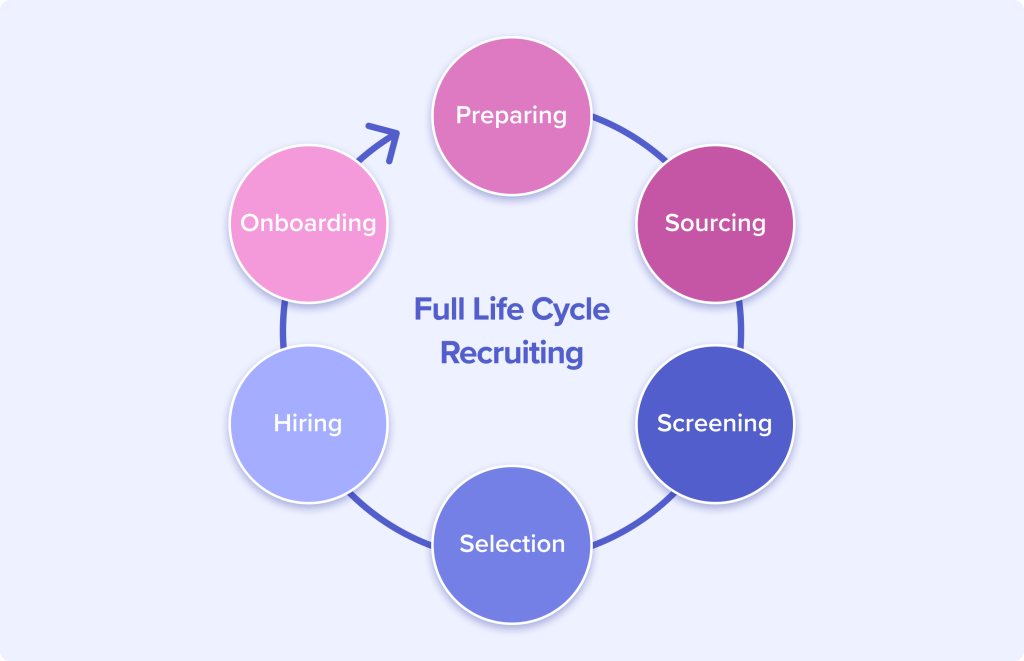Full-cycle recruiting has become a highly effective solution to fragmented hiring processes. This end-to-end recruitment approach, where a single recruiter manages the entire talent acquisition journey—from job posting to employee onboarding—is gaining traction, especially among small and medium-sized businesses. Currently, 60% of companies are adopting this full life cycle recruiting model.
The advantages are clear. According to SHRM research, organizations using full-cycle recruitment experience a 25% reduction in time-to-hire and a 20% boost in candidate experience. Unlike traditional recruitment that delegates tasks among specialists, this unified method improves recruiter accountability, consistency, and builds stronger candidate relationships throughout the hiring lifecycle.
However, only about 30% of HR professionals possess the diverse skill set needed to excel in this comprehensive model. Leveraging recruitment automation tools is increasingly essential as technology evolves, enabling recruiters handling the entire recruitment lifecycle to increase productivity by up to 35%.
This article explores what makes full-cycle recruiting unique, when it’s most effective, and how businesses can use this strategy to enhance hiring outcomes.
Understanding Full-Cycle Recruiting
Full cycle recruiting is a holistic talent acquisition strategy where one recruiter oversees all stages of the hiring process from start to finish. Unlike segmented recruiting models, which divide responsibilities across multiple team members, this approach centralizes the entire process under a single professional.
Also known as end-to-end recruiting or full life cycle recruiting, this method ensures a seamless and consistent candidate experience. It fosters stronger connections between recruiters, hiring managers, and candidates, maintaining continuity from initial contact through successful onboarding.
6 Key Stages of Full-Cycle Recruiting

- Preparing
- Collaborate with hiring managers and stakeholders to identify hiring needs.
- Define the job description, responsibilities, skills, and experience required.
- Create a detailed job requisition outlining expectations.
- Sourcing
- Source candidates through multiple channels, including job boards, social media, networking, and headhunting.
- Build and nurture talent pipelines for challenging roles.
- Use employer branding strategies to attract top talent and showcase company culture.
- Screening
- Review resumes and applications to shortlist qualified candidates.
- Conduct initial phone or video interviews to assess skills, cultural fit, and communication.
- Utilize pre-employment assessments such as skills tests and personality evaluations.
- Selection
- Arrange in-person or panel interviews with hiring managers and key stakeholders.
- Apply structured interview techniques, including competency-based questions.
- Evaluate both technical skills and soft skills like teamwork and leadership.
- Perform reference checks to verify experience and reliability.
- Hiring
- Develop competitive job offers including salary, benefits, and incentives.
- Present and negotiate offers with preferred candidates.
- Ensure alignment between candidate expectations and company standards.
- Finalize the offer and address any concerns.
- Onboarding
- Facilitate a smooth transition for new hires into their roles.
- Provide clear instructions and expectations before day one.
- Deliver a comprehensive onboarding program to integrate employees into the company culture.
- Follow up to ensure new hires receive adequate support and are settling in well.
Advantages and Disadvantages of Full-Cycle Recruiting
Advantages:
- Enhanced Accountability: One recruiter owns the process, ensuring clear responsibility and avoiding fragmented communication.
- Improved Candidate Experience: Candidates enjoy consistent communication and personalized attention, leading to stronger relationships.
- Streamlined Efficiency: Eliminating handoffs speeds up decision-making and reduces delays.
- Data Consistency and Insights: Centralized management enables better data collection and continuous process improvement.
- Reduced Time-to-Hire: Faster hiring cycles decrease the risk of losing candidates to competitors.
- Higher New Hire Retention: A well-managed hiring experience promotes employee engagement and long-term retention.
Disadvantages:
- Volume Limitations: Managing too many openings can overwhelm a single recruiter, affecting quality.
- Skill Set Requirements: Full-cycle recruiters must master diverse skills, which can be hard to find.
- Technology Adaptation: Keeping up with multiple recruitment tools demands ongoing learning.
- Potential Bottlenecks: Having one person responsible may slow the process during peak hiring periods.
How Businesses Can Successfully Use Full-Cycle Recruiting
Hiring a dedicated full-cycle recruiter offers businesses a streamlined and effective approach to talent acquisition. When a single recruiter handles all hiring stages—from sourcing to onboarding—the process gains efficiency, accountability, and better outcomes.
- Streamlined Process: A unified point of contact avoids communication gaps and ensures a smooth candidate and team experience.
- Faster Hiring: The model reduces time-to-hire by speeding decisions and minimizing handoffs.
- Better Communication: Candidates benefit from consistent updates, which builds trust and engagement.
- Higher Quality of Hire: Full-cycle recruiters develop in-depth knowledge of the role and culture, resulting in better candidate matches and retention.